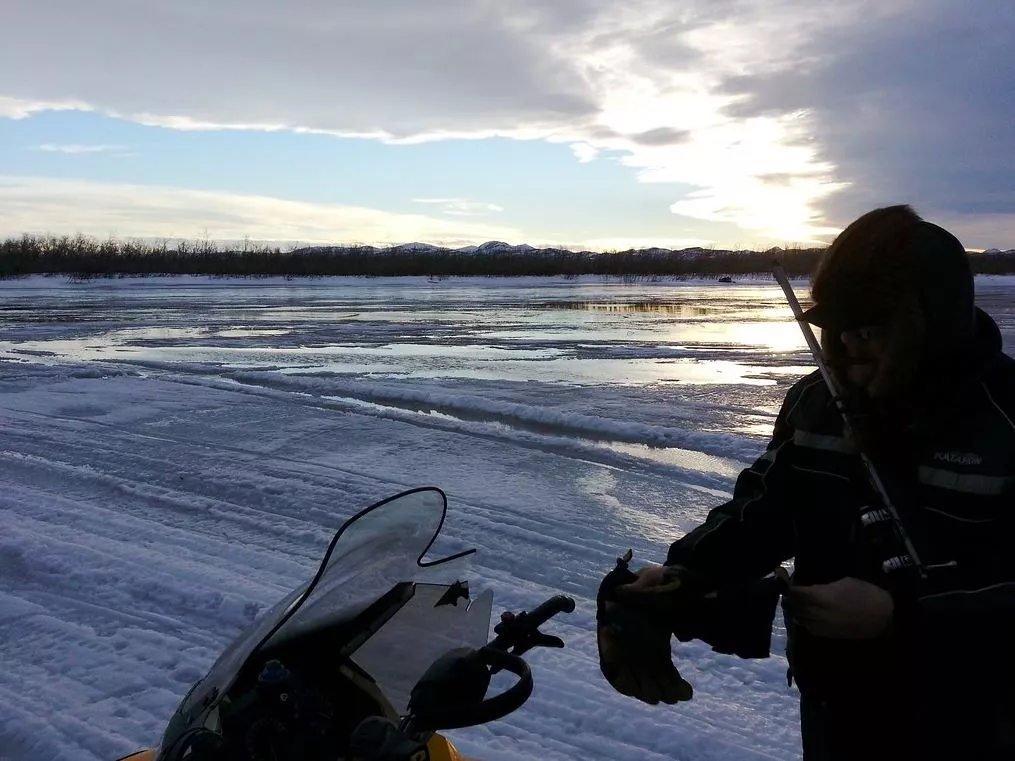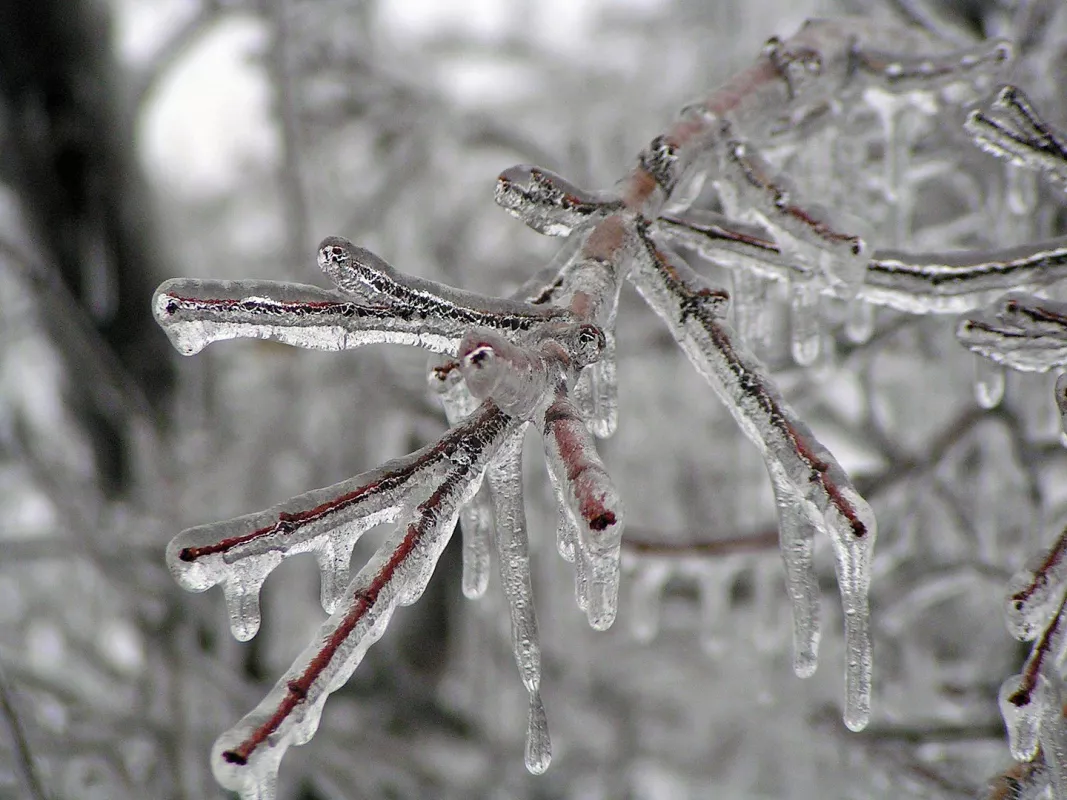By Brigitta Rongstad
A December storm brews over the North Pacific Ocean, just off-shore of the Aleutian Islands. The National Weather Service issues a “winter weather advisory” for Interior Alaska, warning residents to prepare for heavy snow and freezing rain. On Christmas Eve, the storm clouds move in, dumping wet, heavy snow over much of the region. Then the rain starts, and ice begins to accumulate on trees, roads, and buildings.
The historic 2021 Christmas Weekend storm left behind thick layers of ice across interior Alaska, impacting communities and the infrastructure they depend on. In Fairbanks, nearly two inches of snow and freezing rain fell, bringing down power lines. Thousands of people lost power and slick ice made roads and sidewalks unnavigable. Ninety-five miles southwest, in Delta Junction, the roof of the town’s only grocery store collapsed under the immense weight of snow and ice. When a second winter storm passed through Interior Alaska just days later, snow quickly buried the ice, creating a slippery, unseen hazard that persisted well into the following months.
Outsiders might assume this kind of extreme winter precipitation is an expected part of harsh winters in Alaska, or perhaps an unlucky, one-off occurrence in the area. They're neither: as the climate warms, once rare winter rain events are becoming more and more common, and these kinds of changing precipitation patterns threaten people’s livelihoods and the infrastructure that keeps communities running.
“One event can trigger repercussions across the system, affecting transportation, harvest, hunting, and ultimately what is in people’s refrigerators,” said Matthew Druckenmiller, a researcher with the National Snow and Ice Data Center’s (NSIDC) Arctic Rain on Snow Study (AROSS).
Through partnerships with community members and vital climate information recorded by volunteers in local observer networks, the AROSS team aims to better understand rain on snow events and other winter precipitation changes—with a focus on how they impact peoples in the Arctic. Knowing the risks associated with extreme winter weather events could help communities better prepare for and respond to future challenges and adapt to change.
Community-level view is key to understanding a changing Arctic
There’s a storied history of scientists traveling north to study the Arctic—from Fridtjof Nansen’s 1893-1896 Fram expedition to the North Pole to the 2019-2020 Multidisciplinary Drifting Observatory for the Study of Arctic Climate (MOSAiC) expedition to study the Arctic climate system over a full seasonal cycle. But large, extensive research expeditions are costly and few, and smaller fieldwork efforts, which are easier to plan and implement, can be too limited in scope to give scientists the full picture of environmental change.
Farther afield, scientists use satellite imagery and climate models to track changes without visiting the Arctic in person. The work helps researchers fill in important gaps and test hypotheses without needing to observe things first-hand. But still, a vital piece of the puzzle is often missing: local, long-term observations and knowledge.
People have been living in the Arctic for thousands of years—the Inuit, Yupik, Aleut, Gwitch'in, Evenki, and many other Indigenous peoples in Alaska, Canada, Norway, Sweden, Finland, and Russia. Their history and knowledge is important. “People who live in the Arctic have something to add to the science. Including them isn’t just the right thing to do; it also improves science,” said Mike Brook, a data analyst with the Alaska Native Tribal Health Consortium and an AROSS team member.
In many Arctic communities, knowledge is passed down generation to generation, preserving not only the important cultural practices and traditions that tie people together but also the history of the land. People living in the Arctic are intimately familiar with their surroundings—they are the first to know when changing conditions shorten their hunting season or when the only routes (often by air or river) in and out of town become inaccessible. Their familiarity with the landscape around them makes them well-positioned to identify changes in their communities, Druckenmiller said, and that positioning also makes their observations critical for scientists.
“Rain on snow events are related to so many other issues that communities are facing in the Arctic,” said Druckenmiller. “Investigating the causes behind these events is a good first step, but in order to understand the impacts on communities, we need a more holistic view of the system. That’s what makes community knowledge so important.”
Local people know when a weather event is out of the ordinary. They remember when roofs collapse after a snowstorm or when icy roads cut off their access to other places. They feel the cold when power lines are damaged by downed trees or thick layers of ice, cutting off heat. This knowledge is helpful for scientists working to understand how climate change is affecting the Arctic, but it’s also invaluable to communities themselves.
“With a holistic understanding of how changing precipitation affects Arctic communities, people at all scales of decision making can understand the implications of these individual weather events,” Druckenmiller said. “Then people can develop policies or plans to intervene when, say, a community is likely to face a food supply emergency later in the winter.”
Local observer network documents changes change in Alaska, beyond
Observations from the Local Environmental Observer (LEO) Network help highlight the local impacts of rain on snow events and other changing winter precipitation patterns that are the focus of the AROSS project team. Established by the Alaska Native Tribal Health Consortium in 2012, the LEO Network enables Indigenous communities, reindeer herders, and other local groups to share critical information about “unusual animal, environment, and weather events” and their impacts on the environment and communities. A subsistence harvester might submit an observation about a river crossing with abnormally thin ice, too thin for their snow machine to cross, cutting off access to their traditional harvest land. Or a business owner might share images of downed power lines in town after a big winter storm.
The network also incorporates reports from local newspapers. “The idea was to create a place where Indigenous and local knowledge could be given equal footing with western scientific knowledge,” Brook said.
The LEO Network brings that critical human, local element to the AROSS project. Researchers can use information from the online platform to identify how specific events impacted communities—for example, what happened to roads or buildings after the 2021 Christmas weekend winter storm in Alaska? And LEO observations can help scientists identify future lines of inquiry and important science questions, too: how do extreme winter precipitation events change surface conditions in the Arctic, for example.
With 10 years of environmental information stored in the LEO Network and countless local observations and oral histories preserved elsewhere, there’s a lot for AROSS researchers to dig through. “It’s important that we do our homework on what communities have already shared,” Druckenmiller said.
But the value of the local observations extends even further. LEO observations can help people understand and better prepare for the impacts of climate change in their communities. The documented impacts of a rain on snow event in one community can inform others in the region about potential hazards and risks in their own communities. This kind of information is vital for people needing to adapt to change in the Arctic.
“The most important reason to include local observation and knowledge is to make sure the human-level impacts are not forgotten. It simply isn't possible to observe those from a satellite,” Brook said.
AROSS looks toward the future
During the first two years of the project, the AROSS team dug through satellite and modeling data to determine the causes behind rain on snow. They found a strong relationship between rain on snow events and atmospheric rivers, bands of moisture in the atmosphere that transport large amounts of water from place-to-place. Team members also worked with the LEO Network to add rain on snow to its list of topics, enabling community members to tag and search for rain-on-snow events in the database. In the final two years of the project, the AROSS team hopes to increase their focus on communities.
“Ultimately, the goal is to build an expert model of how changing precipitation patterns influence communities, how a trigger at one place at one time can have repercussions across the system,” Druckenmiller said. “For example, we know a rain-on-snow event in December can have implications for travel for months.” That kind of knowledge can help communities be more resilient.
And it relies on researchers and community members working closely together. COVID and global politics have prevented some in-person interactions for a couple years now, and planning is now underway for the very first in-person AROSS project team event. Fittingly, the focus of the meeting will be on relationship-building and community knowledge: during the Arctic Ungulate Conference in Anchorage, Alaska, in May 2023, the AROSS team, in partnership with the LEO Network, will lead a community event centered on the topic of shared knowledge. The event will bring together scientists, community members, and herders from Alaska, Scandinavia, Arctic Russia, and Nunavut, Canada, setting the stage for potential partnerships. Scientists and community members plan to share knowledge about rain-on-snow events and other changing winter precipitation patterns, and their impacts on Arctic communities.
“A real challenge for our work is to develop a path forward where equitable and cross-cultural knowledge sharing allows us to eventually develop actionable information that helps people in their daily lives,” Druckenmiller said.


